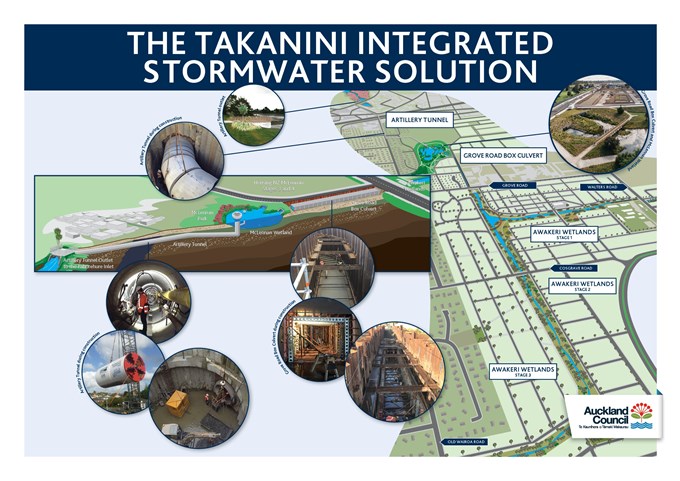It rained and rained as herons, waders and pukeko looked on and local iwi, residents, elected representatives, contractors and team members from Healthy Waters planted native trees to mark the completion of a significant rejuvenation project in Takanini to fix flooding and unlock swampy land for housing development.
Auckland Council is investing around $100 million in the area with the first two projects in this massive infrastructure upgrade successfully completed to increase capacity to the stormwater network and reduce flooding.
“The Artillery Drive stormwater tunnel and Grove Road box culvert are engineering feats and examples of how teamwork, specialist knowledge, new technology and a 'can do - will do' culture has succeeded in bringing in these big transformational projects on time and budget – and importantly without incidents despite often hazardous conditions,” says Healthy Waters General Manager, Craig McIlroy.

Currently underway across the road, is the first stage of the three-stage Awakeri Wetlands Project which is the final piece in this flood alleviation puzzle and another step in seeing the future of a new community, connecting people to nature, literally rise from the swamp.
Local resident Leah Wharepapa who attended was enthusiastic about the wetland amenity in her new neighbourhood. “It’s beautiful,” she said. Another attendee said “the kids used to play rugby in what was essentially a swamp. But look at it now. There are even fish passages”.
“We have a chance to get it right with these projects and put the community first, protecting people and property from floods and also taking care of our natural water and wetland assets, ” Mr McIlory said at the opening ceremony lead by representatives of Ngati Tamaoho, Ngati te ata, Ngai Tai ki Tamaki and Te Akitai Waiohua.
Key facts
Artillery Drive Stormwater Tunnel
- The was project managed by Pradip Baisyet and Dietmar Londer from Healthy Waters; the designer was Jacobs New Zealand Limited and contractor McConnell Dowell Constructors Limited
- The tunnel is approximately 1.1 km long - the pipes which run its whole length are 2.5 metres in diameter and some have had to be laid up to 13 metres underground.
- It has the capacity to convey large volumes of stormwater from the McLennan Park Wetland to the Pahurehure Inlet by Katavic Park to decrease flooding events and enable residential development in parts of the Takanini Greenfield Area. This includes Housing New Zealand homes.
- Five 6-13 metre shafts were sunk, and the team had to work fast driving in new piles to reinforce the soft walls, high groundwater table and lay the concrete platform for the hydraulic jacks and boring machine to run along.
- The tunnel sections were constructed using a Pipe Jacking machine with huge cutterheads to drive through often hard rocks – and yet no one heard a thing above ground.
- The 2.5 metre pipes were installed to high accuracy using computerised systems and no settlement or dislocation along the alignment occurred.
- This technology is now being used by Healthy Waters on other projects.
Grove Road Box Culvert
- Construction, under Project Manager, Tony Morley, was carried out by contractor HEB within a very challenging timeframe and in co-ordination with Housing New Zealand’s development on the site.
- The high-water table and soft peat soil so prone to collapse were challenges to the construction of the 0.5 km long concrete culvert.
- It runs underneath Battalion Drive and connects the Awakeri Wetlands, now under construction, to the McLennan Wetland channel through Housing New Zealand land which has now been developed to provide new homes.
- It is a vital component in the big picture flood mitigation plan for Takanini – and also provides a fish passage as we reclaim the Awakeri wetlands.
- What you see today is a landscaped open channel and increasingly attractive community wetland, but this was a major construction project that basically took place in a bog.
- Due to the sheer size of the culvert, the ground is unable to support the weight of a crane lifting pre-cast culvert sections, so the culvert had to be built in place.
- The team had to excavate to around seven metres below ground to build the sheet piled trench, stabilise the ground and stem the tide of rising groundwater.
- Once stabilised, the trench was ready to start the process of building the concrete culvert in situ.
- The team, by working from both ends of the trench, completed 24-metre sections each month to come in on time and on budget – and without injury in these difficult and potentially hazardous conditions.




